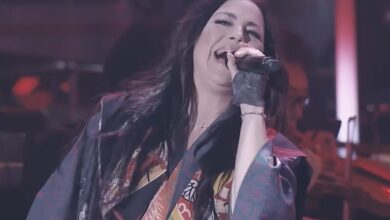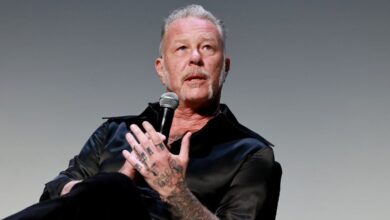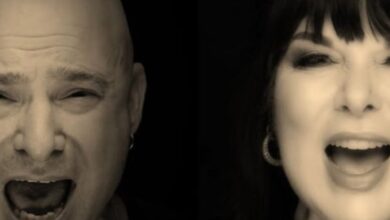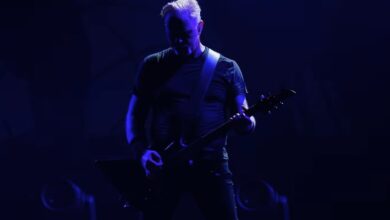Aerosmith and YUNGBLUD Ignite a Digital Firestorm with Their Electrifying “Problems” Visualizer Released on November 26, 2025
When Aerosmith and YUNGBLUD released the “Problems (Official Visualizer)” on 26 November 2025, it didn’t arrive like a typical YouTube drop—it felt like a world premiere inside a digital concert hall. From the moment the first beat landed, the visualizer gave the impression of a performance unfolding in real time, mixing the grit of rock with the restless pulse of modern alt-pop. It made the collaboration feel alive, urgent, and louder than the screen it played on.
The release instantly caught attention because it wasn’t just a video—it felt like a continuation of the musical conversation they started earlier in the year. With Aerosmith returning after years away from the studio and YUNGBLUD standing at the height of his momentum, the visualizer became the perfect bridge between two eras. It gave the track the same atmosphere you’d expect from a late-night arena show, even though it existed entirely in digital form.
“Problems” sits on their collaborative EP One More Time, and even before the visualizer dropped, fans already sensed this track carried a unique emotional weight. But seeing it paired with intense motion graphics, shifting color palettes, and a moody cinematic backdrop crystallized its raw tone. It wasn’t flashy for the sake of flash; it was styled to mirror the chaos, confession, and vulnerability woven into the lyrics and instrumentation.
Part of the magic comes from the push-and-pull between Steven Tyler and YUNGBLUD. Their vocals don’t compete—they collide, merge, and pull apart in a way that feels like listening to two generations trying to work through the same emotional storm. The visualizer amplifies this tension. The cuts, the motion, the pulsing shapes—it all feels synchronized with the feeling of two different worlds trying to coexist inside the same frequency.
The instrumentation feels even larger with the video backing it. Joe Perry’s guitars come in like a spotlight beam steering through smoke, while the beat pounds with the kind of forward momentum that makes you imagine a real crowd jumping in unison. The visualizer leans into that energy by framing everything in wide strokes—sharp flashes, shifting angles, and a sense of movement that makes you feel like the track is physically pushing against its own boundaries.
When YUNGBLUD’s voice cracks into the song’s emotional confessions, the visualizer darkens and tightens, mirroring the sense of someone wrestling with the pressure of being seen from all angles. His performance carries the tone of a young artist confronting the cost of ambition, fame, and self-exposure. The video enhances that by turning the screen into a sort of emotional chamber—echoes of neon, shadows, and static that match the internal chaos he sings about.
Then Steven Tyler enters with that unmistakable veteran command. His voice brings a weight that doesn’t need explanation—decades of lived experience compressed into each phrase. The visualizer shifts again when he appears, brightening and widening as if the song suddenly expands in scale. Tyler doesn’t just add harmony; he adds gravity, anchoring the whirlwind with the voice of someone who’s survived everything the song describes.
The chemistry between the two is undeniable. The visualizer blends their worlds with a rhythmic pulse that makes their vocals feel like they’re chasing each other through the frame. It captures this dynamic beautifully—a tug-of-war between youthful urgency and seasoned wisdom. It’s the kind of pairing that feels unlikely on paper but lands perfectly when you watch it unfold in motion and color.
As the track progresses, the visualizer embraces the song’s theatrical side. Shapes stretch, glitch, and bloom across the screen in sync with rising vocal layers. It feels like the digital equivalent of stage lights exploding during a chorus. That’s what gives this release a concert-story quality: the sense that you’re witnessing an emotional crescendo rather than just listening to a studio track.
About halfway through, the video hits a kind of emotional pivot. The motion slows, the colors cool, and the feeling shifts from confrontation to reflection. For a moment, it feels like the entire song is exhaling—letting the listener sit inside the tension instead of pushing through it. This contrast makes the final chorus land with even more force when the energy surges again.
When the climax arrives, the visualizer erupts in a swirl of motion. The screen feels alive—flashes matching the kick drum, shapes punching forward with the vocal accents, and colors bleeding outward as the two voices unite in the most dramatic section of the track. It mirrors the sensation of standing in the middle of a loud, messy, cathartic live finale.
One of the most striking qualities of this visualizer is the way it treats the song like a narrative. Each section feels like a different emotional chapter, building a sense of rising and falling tension. That’s why the track works so well in visual form—it isn’t just a catchy collaboration; it has the structural bones of a cinematic story, and the video leans into that quality with confidence.
As the final notes ring out, the visualizer doesn’t simply fade—it dissolves in a way that suggests unresolved emotion, which fits the theme perfectly. “Problems” isn’t a song about solutions; it’s a song about being honest in the middle of the mess. The ending reinforces that feeling, leaving a lingering vibrational aftertaste like the distant echo of a concert ending long after the lights come up.
The immediate fan reaction has been explosive. Within hours of the release on November 26, comment sections filled with listeners saying the collaboration feels bigger, bolder, and more emotionally charged with the visualizer in place. Younger fans gravitate toward YUNGBLUD’s rawness, while classic rock fans feel the unmistakable fingerprints of Aerosmith in the instrumentation and drama. The cross-generational blend that once seemed experimental now feels completely natural.
Ultimately, the “Problems” visualizer isn’t just a promotional piece—it’s an extension of the song’s emotional architecture. It transforms the track into an experience, something closer to a digital concert performance than a static companion video. By giving shape and motion to the emotional turbulence inside the lyrics, Aerosmith and YUNGBLUD created a release that feels alive, cinematic, and unmistakably 2025.
And as that final flicker fades from the screen, the feeling it leaves behind is the same one you get walking out of a dark arena into the cool night air—the sense that you just witnessed something loud, human, and unforgettable.





